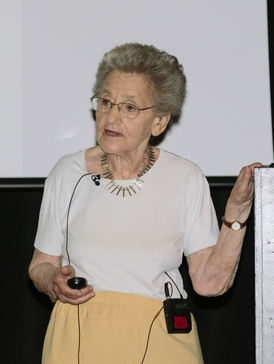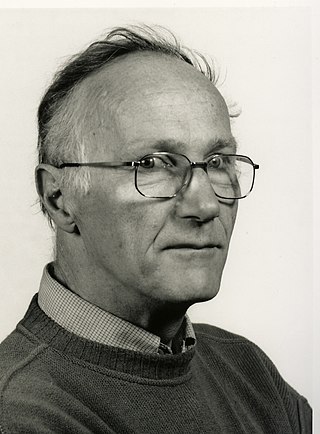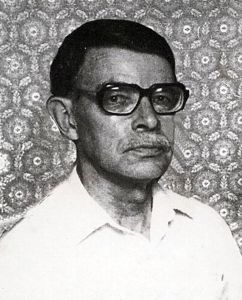Related Research Articles

Crystallography is the experimental science of determining the arrangement of atoms in crystalline solids. Crystallography is a fundamental subject in the fields of materials science and solid-state physics. The word crystallography is derived from the Ancient Greek word κρύσταλλος, and γράφειν. In July 2012, the United Nations recognised the importance of the science of crystallography by proclaiming that 2014 would be the International Year of Crystallography.

X-ray crystallography is the experimental science of determining the atomic and molecular structure of a crystal, in which the crystalline structure causes a beam of incident X-rays to diffract in specific directions. By measuring the angles and intensities of the X-ray diffraction, a crystallographer can produce a three-dimensional picture of the density of electrons within the crystal and the positions of the atoms, as well as their chemical bonds, crystallographic disorder, and other information.
Paul Peter Ewald, FRS was a German crystallographer and physicist, a pioneer of X-ray diffraction methods.
The Ewald sphere is a geometric construction used in electron, neutron, and x-ray diffraction which shows the relationship between:

Olga Kennard, Lady Burgen was a Hungarian-born British scientist who specialised in crystallography. She was the founder of the Cambridge Crystallographic Data Centre.
In crystallography, a Wyckoff position is any point in a set of points whose site symmetry groups are all conjugate subgroups one of another. Crystallography tables give the Wyckoff positions for different space groups.
Ralph Walter Graystone Wyckoff, Sr. was an American scientist and pioneer of X-ray crystallography. He was elected member of the National Academy of Sciences in 1949 and Foreign member of the Royal Society, on April 19, 1951.
Diffraction topography is a imaging technique based on Bragg diffraction. Diffraction topographic images ("topographies") record the intensity profile of a beam of X-rays diffracted by a crystal. A topography thus represents a two-dimensional spatial intensity mapping (image) of the X-rays diffracted in a specific direction, so regions which diffract substantially will appear brighter than those which do not. This is equivalent to the spatial fine structure of a Laue reflection. Topographs often reveal the irregularities in a non-ideal crystal lattice. X-ray diffraction topography is one variant of X-ray imaging, making use of diffraction contrast rather than absorption contrast which is usually used in radiography and computed tomography (CT). Topography is exploited to a lesser extends with neutrons, and is the same concept as dark field imaging in an electron microscope.
Acta Crystallographica is a series of peer-reviewed scientific journals, with articles centred on crystallography, published by the International Union of Crystallography (IUCr). Originally established in 1948 as a single journal called Acta Crystallographica, there are now six independent Acta Crystallographica titles:
David Sayre was an American scientist, credited with the early development of direct methods for protein crystallography and of diffraction microscopy. While working at IBM he was part of the initial team of ten programmers who created FORTRAN, and later suggested the use of electron beam lithography for the fabrication of X-ray Fresnel zone plates.

Kedareswar Banerjee was an X-ray crystallographer and director of the Indian Association for the Cultivation of Science, Kolkata. Early in his career he determined the structures of naphthalene and anthracene. In 1931, he worked with Sir William Henry Bragg and developed one of the first direct methods of crystal structure determination. He was Professor of Physics at the Indian Association for the Cultivation of Science from 1943 to 1952 and Director of the Association from 1959 until his retirement in 1965. Between 1952 and 1959 he was Head of the Department of Physics at Allahabad University. His interests in crystallography were widespread and, with his death, India has lost a renowned teacher. K. Banerjee joined the research group of Sir C. V. Raman at the Indian Association for the Cultivation of Science (IACS), Calcutta, a premier Indian research institute of India. He worked in various institutions including IACS, the India Meteorological Department, University of Dhaka and Allahabad University and finally retired as the Director of IACS, Calcutta in 1965. Prof. Banerjee explained some points of crystal research to Homi J. Bhabha also.
In crystallography, mosaicity is a measure of the spread of crystal plane orientations. A mosaic crystal is an idealized model of an imperfect crystal, imagined to consist of numerous small perfect crystals (crystallites) that are to some extent randomly misoriented. Empirically, mosaicities can be determined by measuring rocking curves. Diffraction by mosaics is described by the Darwin–Hamilton equations.

The European Crystallographic Association (ECA) is an independent scientific organisation, representing both national crystallographic associations in Europe as well as individual members. ECA was founded in 1997. In May 2021 the association had 35 national and several hundred individual members. ECA is one of the regional affiliates of the International Union of Crystallography. The other independent regional affiliates are the American Crystallographic Association, the Asian Crystallographic Association and the Latin American Crystallographic Association. The association is registered under Dutch law in Zeist.
Aafje Looijenga-Vos was a Dutch crystallographer. She was a professor for general chemistry and later for structural chemistry at the University of Groningen.
In 1986 the International Union of Crystallography (IUCr) established the Ewald Prize for outstanding contributions to the science of crystallography. The Ewald Prize is considered the highest prize available to crystallographers apart from the Nobel Prize. The Ewald Prize has been described as prestigious, acclaimed and coveted.

Theo Willem Jan Marie Janssen, better known as Ted Janssen, was a Dutch physicist and Full Professor of Theoretical Physics at the Radboud University Nijmegen. Together with Pim de Wolff and Aloysio Janner, he was one of the founding fathers of N-dimensional superspace approach in crystal structure analysis for the description of quasi periodic crystals and modulated structures. For this work he received the Aminoff Prize of the Royal Swedish Academy of Sciences in 1988 and the Ewald Prize of the International Union of Crystallography in 2014. These achievements were merit of his unique talent, combining a deep knowledge of physics with a rigorous mathematical approach. Their theoretical description of the structure and symmetry of incommensurate crystals using higher dimensional superspace groups also included the quasicrystals that were discovered in 1982 by Dan Schechtman, who received the Nobel Prize in Chemistry in 2011. The Swedish Academy of Sciences explicitly mentioned their work at this occasion.
This is a timeline of crystallography.
Isidor Fankuchen was an American pioneer of crystallography. Known to his friends as "Fan" he was from a Jewish family of Dutch origin and trained in Cornell and under W.L. Bragg and J.D. Bernal. He was one of the founders of the International Union of Crystallography (1945). His name has mistakenly been recorded also as Isadore van Kueken.
John R. Helliwell is a British crystallographer known for his pioneering work in the use of synchrotron radiation in macromolecular crystallography.

Yuri Timofeevich Struchkov was a Russian and Soviet chemist. He was a prominent scientist in the field X-ray crystallography, a Corresponding Member of the Russian Academy of Sciences (1990) and the vice-president of the International Union of Crystallography (1993-1995). Struchkov was the founder and the first Director of the X-Ray Structural Laboratory of Nesmeyanov Institute of Organoelement Compounds and X-Ray Structural Centre of the Russian Academy of Sciences (RAS). He made important contributions to the fields of chemistry and crystallography of organic, organoelement and coordination compounds. As an author and co-author of more than 1000 papers, published between 1980 and 1990, he became the most widely published scientist of the decade. In 2021, the International Union of Crystallography (IUCr) honored his contributions to the field of small molecule structural crystallography, establishing the Struchkov Prize, which is awarded to the young crystallographers at the regular triennial IUCr International Congress of Crystallography. Robert Fayzullin of Arbuzov Institute of Organic and Physical Chemistry, Kazan, Russia, won the 2023 Struchkov Prize for his work on the real-space interpretation of chemical bonding by combining one-electron potentials and associated force fields derived from high-resolution X-ray diffraction data.
References
- ↑ "Crystallography Journals Online". Crystallography Journals Online. The International Union of Crystallography.
- ↑ "International Tables for Crystallography". International Tables for Crystallography. International Union of Crystallography.
- ↑ "IUCr Newsletter". IUCr Newsletter. The International Union of Crystallography.
- ↑ "World Directory of Crystallographers". World Directory of Crystallographers. The International Union of Crystallography.
- ↑ "The Ewald Prize". The Ewald Prize. The International Union of Crystallography.
- 1 2 3 Kamminga, Harmke (1989). "The International Union of Crystallography: its formation and early development". Acta Crystallogr. A45 (9): 581–601. doi:10.1107/S0108767389003910.
- ↑ Ewald, Paul P (ed.). "The Consolidation of the New Crystallography". The International Union of Crystallography.
- ↑ With one very distinguished exception, the German physicist Max von Laue, who won the 1914 Nobel Prize for his discovery of X-ray diffraction in crystals, whose invitation and acceptance required some degree of political and personal courage by both Bragg and von Laue.
- ↑ "Ralph W. G. Wyckoff 1897-1994," Acta Crystallogr. (1995). A51, 649-650. Accessed online at http://ww1.iucr.org/people/wyckoff.htm Archived 2010-11-07 at the Wayback Machine on 3/23/2010
- ↑ "Obituary: Arne Westgren 1889-1975" (PDF). The International Union of Crystallography.
- ↑ "(IUCr) Aspects of the History of the IUCr". cristal.org. Retrieved 2023-05-01.
- ↑ "Previous Executive Committees". www.iucr.org. Retrieved 2023-05-01.